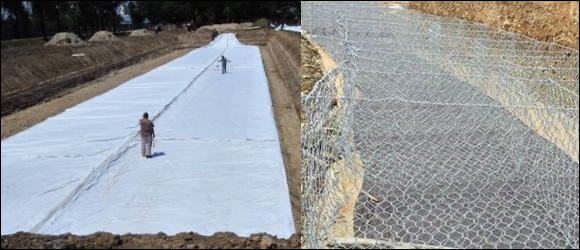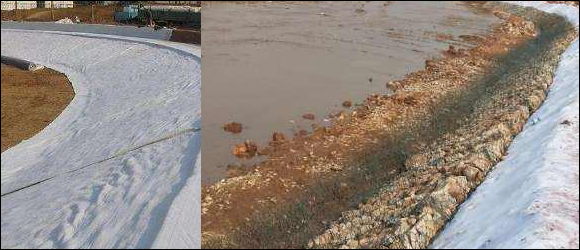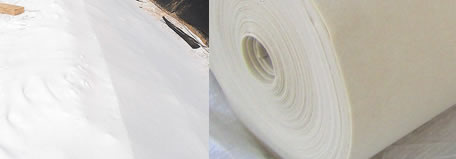Gabions Products
- Military Gabions

- Hot Dipped Galvanized Gabion Mesh Cells

- Welded Mesh Gabions Architectural Wall Cladding

- Gabions (Gabiony)
- Galfan + PVC Coated Gabions
- Gabion Mattresses for Flood Protection Embankment
- Planted Gabion Walls

- Gabions and Geotextiles for Bridge Construction
- Gabion Basket Hot Dip Galvanized
- Gabions P. V. C. Coated Galvanised Wire Box
- Gabions River Training Works
- Geotextile Fabric
- Woven Wire Mesh Cages for Gabion Project
- Gabion Fence
- Welded Gabions Coating Galfan
- Gabion Baskets Double Twisted Galvanized
- Triple Twisted Wire Mesh Gabions
- Gabion Box
- Woven Gabions
- Gabion Baskets
- Wire Mesh Gabion Mattress
- Gabion Cages (Stone Box)
- Gabion Wall
- Hexagonal Gabions Netting
- Gabions Machine
- Welded Gabions
- Sack Gabions
- Reinforced Gabions
- Gabion faced reinforced soil walls
- Gabion Mattress
- Gabions for Water Conservancy
- Gabions for Bridge Protection System
- Gabion Wall Drop Structures
- Modular Gabions as Architectural Elements
- Gravity Wall of Gabions
- Gabions for Headwalls or Wingwalls
- Channel Linings
- Modular Gabions for Rockfall Netting System
Geotextile Fabric-Non-woven Geotextile PP 200gsm m2, 300gsm, PET 300gsm- River Bedding Filter and Reinforcing Material
Geotextile is also called Geotextile filter fabric, or Geo Textile, a kind of synthetic fabric to improve soil stability, control erosion, and enhance drainage in civil engineering and construction projects.
Geotextile fabrics are commonly placed on the surfaces under gabion rip rap, stone beaching, retaining walls, drainage backfill as filter cloth material for draining and soil retaining in bank protection gabion works.
Geotextile fabrics are supplied both needle punched non woven type and woven polymer type, both offering excellent tensile strength and UV resisting property.
Non woven geo textile fabric is a thermally bonded synthetic homogeneous sheet made from a continuous filament and needle punched, popularly used in reinforcing and separating materials in gabion work infrastures construction.
Geotextile Fabric and Geo-Bag
Geo Textile Fabric Non oven needle punched type
Mass ≥ 400gm/m²
Thickness (under 2 kpa pressure )≥ 3.00 mm
EoS ≤ 0.08 mm
Strip tensile strength ≥ 23 kn/m
Grab strength ≥1500 N
CBR puncture resistance ≥3800 N
Elongation maximum force machine direction (MD)≥60% and ≤100 % elongation at maximum force (CMD) ≥40% and ≤100%
Horizontal and vertical permeability (under 2 kn/m² pressure ) ≥ 2x10E-3 m/sec
Geotextile certified by ISO and clearly labeled with brand name and grade printed at regular
Geo-bag
Geo bags
Size 1200mm X 900mm
Geo-fabric th≥3.0mm, fill volume 0.1664 cum, wt 250 kg
Non-woven geotextile PP
Specification:
PP Geotextile 200gsm m2
PP Geotextile 300 gsm m2
PET Non-woven geotextile
Specification:
PET Geotextile 200 gsm m2
PET Geotextile 300 gsm m2
White color (size: 5.9x100meter)
General requirements for geotextile filter fabric
The geotextile filter fabric shall meet or exceed the requirements stated hereunder in full. The geotextile filter fabric shall be polymer sheet of woven polypropylene of minimum sheet or non woven. The fabric shall be inert to chemicals commonly encountered in sea water and natural soil conditions. In particular it must be non-biodegradable, resistant to most soil chemicals and bacteria, unaffected by acids and alkalines within a PH range of 3 to 12 and treated during the manufacturing process to withstand prolonged e:xposure to ultraviolet degradation.
Required properties for geotextile filter fabric
The geotextile filter fabric delivered to the site shall meet or exceed the technical values stated below, guided by IS09001.
Properties and approved methods of testing of geotextile filter fabric
Geotextile Property |
Min, Average Roll Value |
Approved Method of Testin |
Weight (mass per unit area) |
2350 m2 |
EN 965 |
Nominal tensile strength at wrap and weft direction |
2 80 kN/m |
EN ISO 10319 |
Tensile elongation at nominal strength at wrap and weft direction |
12% |
EN ISO 10319 |
CBR puncture resistance |
2 6 kN |
EN ISO 12236 |
Characteristic pore size 090 (dry sieved) |
250 pm |
BS 6906 2 or NEN 5168 |
Characteristic opening size 090 (wet sieving) |
200 um |
EN ISO 12956 |
Water Permeability |
2 0.010 m/sec |
EN-ISO 1 1058 |
Ultra Violet resistance (Xenon test) |
2 75% of ultimate tensile stren th |
ASTM D4355-92 |
Note: The UV stability of the fabric shall be such that after 500 hours of accelerated weathering in a Xeri0 test 1200, according to ASTM D4355-92, the fabric shall retain at least 75% of its minimum strip tensile strength.

Delivery requirements for Geo Textile
Geotextiles are delivered in rolls of minimum width 5.00 meters. The length of each roll shall be at least 200 meters. Or custom requirements.
Geotextiles shall be delivered in packaging suitable for the protection of the rolls from degradation by ultra violet light. The labelling shall clearly identify the product supplier in accordance with BS EN 30320.
Transportation and Storage requirements
During all periods of shipment, land transportation and storage the filter fabric shall be protected from direct sunlight, ultra violet rays and temperatures greater than 600 C. Geotextiles shall be protected at all times against physical or chemical damage. Geotextiles shall be kept in the wrappings provided by the manufacturer. The Supervisor shall reject filter fabric if it has been removed from its protective cover for more than 72 hours prior to use, or if it has defects, tears, punctures, shows deterioration, or damage incurred during manufacture, transponation, or storage. The rolls of geotextile shall be stored on level ground and stacked not more than five rolls high and no other materials shall be stacked on top of the geotextiles.
Sampling and testing of geotextile filter fabric
Prior to provisional acceptance, samples of the geotextile shall be taken in accordance with the requirements of ISO 9862: 1990 at the rate of one set per 20 number of rolls.

Side slope combined protective work of gabions stone cage and Geotextile Fabric

Specification the Geotextile Fabric shall comply with the following Data:
(a) Tensile strength(DIN 53857) 225 N/50mm
(b) Elongation at break(DIN 53587) 50%-80%
(c) CBR test resistance(DIN 54307) 1.1kN
(d) Grab strength(ASTM 1682) 0.3kN
(e) Permeability (100mm pressure) 400l/m2/sec
(f) Mass 90 gm/m2
How to Use Geotextile Fabric in Bank Protection Constructions:
Overlay of the fabric shall take place as soon as possible after placement of the fabric. The fabric shall be joined by overlapping with a minimum overlap of 300 mm above water level and 900 mm below water level.
Aerct supplies Geotextile Fabric meeting the construction techniques and that the fabrics are not pierced or damaged during the entire construction period.
The unit of measurement for geotextile fabric shall be in square metres of area shown for coverage. This rate shall cover the supply and installation of the geotextile fabric, inclusive of wastage and overlapping, and includes all plant, labour and materials necessary to carry out the work.
Rock rip rap bank protection with Geotextile lining:
Rock for rip rap protection shall be of the weight and specific gravity approved by the Engineer and shall comprise hard, durable, crushed, quarried or natural stone. The rock shall be free of weak laminations and cleavages.
Preparation of Slopes
Slopes shall be shaped to allow the full thickness of the specified rip rap, and filter material. Slopes shall not be steeper than the slope specified in the Drawings. Where the slopes cannot be excavated to undisturbed material, the underlying material shall be compacted in accordance. A footing trench shall be excavated along the toe of the slope where detailed in the Drawings.
Bedding
Filter fabric shall be placed immediately prior to rock rip rap.
Rock rip rap shall be placed such that the laps in the filter cloth are maintained at all times.
Placing Rip Rap
Rip rap may be placed by hand or by machine and shall be placed to provide a minimum of voids. Stone may be placed by dumping and spreading in layers by bulldozers or other equipment.
Various Applications of Geotextiles:
Filtration
Geotextile can be the filtration layer of the dykes, river canal, seacoast, concrete slope, retaining walls. At the same time of preventing the clay granule from passing, it allows the water and the gas pass through freely.
Separation
The isolation of the railway dregs and the roadbed, roadbed and the soft base, surface of the airdrome and parking lot and the groundsill, different dam materials.
Reinforcement
The highway, railway, soil-stone dam, breakwater, airport, backfill soil of retaining wall, slope protection, etc in which distributes the earth stress, prevents the side-displacement of the earth body and improves the earthbody stability.
Protection
It prevents the bank from being washed out, protects the bank and the bottom, prevents the water and soil from being washed away.
Technical sheet of Polymer Geotextile:
| No. | Items | unit | 100 | 200 | 300 | 400 | 500 | 600 | 800 | 1000 | ||
| 1 | Weight Variation | % | ±5 | ±6 | ±6 | ±6 | ±6 | ±6 | ±6 | ±6 | ||
| 2 | Grab strength | MD | ≥ N | 350 | 700 | 1100 | 1400 | 1800 | 2200 | 2800 | 3400 | |
| CD | 350 | 700 | 1100 | 1400 | 1800 | 2200 | 2800 | 3400 | ||||
| 3 | Grab elongation | MD | % | 50 ~ 90 | 50 ~ 100 | |||||||
| CD | 50 ~ 90 | 50 ~ 100 | ||||||||||
| 4 | Trapezoid Tear | MD | ≥ N | 135 | 280 | 350 | 400 | 480 | 550 | 650 | 750 | |
| CD | 135 | 280 | 350 | 400 | 480 | 550 | 650 | 750 | ||||
| 5 | CBR bursting strength | ≥ KN | 1.0 | 2.1 | 3.2 | 3.8 | 4.5 | 5.5 | 6.5 | 7.5 | ||
| 6 | Breaking strength | MD | ≥ KN | 3.5 | 8 | 12 | 18 | 24 | 30 | 40 | 50 | |
| CD | 3.5 | 8 | 12 | 18 | 24 | 30 | 40 | 50 | ||||
| 7 | Breaking elongation | MD | % | 40 ~ 65 | 50 ~ 80 | |||||||
| CD | 40 ~ 65 | 50 ~ 80 | ||||||||||
| 8 | Puncture strength | ≥ N | 180 | 360 | 550 | 750 | 900 | 1150 | 1450 | 2000 | ||
| 9 | Thickness | mm | 1.4 ~ 1.7 | 1.8 ~ 2.2 | 2.4 ~ 2.8 | 3.0 ~ 3.5 | 3.6 ~ 4.0 | 4.0 ~ 4.4 | 4.8 ~ 5.2 | 5.6 ~ 6.0 | ||
| 10 | Peel strength | N / 5cm | ≥ 80 | ≥ 100 | ||||||||
| 11 | Acid and alkali | % | Keep the rate of breaking strength≥ 90% Keep the rate of breaking elongation≥ 90% |
|||||||||
| 12 | Sieve size O90 | mm | ≤0.1 | |||||||||
| 13 | Vertical permeability coefficient | Cm / s | ≤0.2 | |||||||||
